Michigan vegetable crop report – July 31, 2024
Warm weather, more harvests and new pest problems are occurring.

Weather
The season so far has ranged from cooler and drier in the Upper Peninsula to warmer and wetter moving to the south.
The forecast for this week predicts:
- Partly cloudy, very warm and humid with scattered showers and thunderstorms possible Wednesday, July 31, into early Thursday. More numerous showers and thunderstorms will develop across lower Michigan late Thursday and continuing Friday.
- Fair and very warm Saturday with isolated showers possible to the south. Mostly dry and cooler Sunday and Monday. Showers and thunderstorms are possible again by Tuesday.
- High temperatures generally in the mid- to upper 80s through Saturday but cooler near the lakes. Highs cooling to the mid- and upper 70s by early next week. Low temperatures in the mid- to upper 60s Thursday through Saturday, cooling to the 50s by early next week.
- Normal to slightly above normal daily potential evapotranspiration (PET) rates expected this week (daily values from 0.16 – 0.20 inches).
- Medium and long-range outlooks generally call for cooler than normal weather by the second week of August. Normal to above normal precipitation totals are expected.
Nutrient management survey
Soil nutrient deficiencies that limit crop yield are often foremost on farmer’s minds but nutrient excesses, especially phosphorus and nitrogen, seem to grab the headlines. Michigan State University Extension is asking farmers from all types of production systems to help identify practices they use by filling out a brief anonymous online survey describing soil conditions and approaches used for soil phosphorus and nitrogen management. Read more information and access the survey here.
Produce food safety On-Farm Readiness Reviews
Schedule an On-Farm Readiness Review (OFRR) today for a 2-hour educational visit that takes place during the harvest season and is meant to be casual and low stress! Everything discussed during an OFRR is confidential and focused on ways you can reduce your own risks in relation to produce safety. There is no pressure to take our advice either, we are just here to support you in your produce safety efforts!
Corn-belt aphids head up to Michigan
Michigan attracts many visitors from south of our state’s border and has recently included winged visitors called corn leaf aphids. The likely sources are outbreaks in corn-belt field corn. When populations get large, aphids form a stage called alates, which have wings. These exploring mamas left crowded corn country and flew north. Scouts and growers in west Michigan began noticing them late last week and over the weekend.
In the short term, corn leaf aphid is not an issue in most vegetables except sweet corn. This is because it can only reproduce on grass-family crops. The winged aphids are like explorers, they land in many places that won’t be a good home. For example, growers and scouts have seen them in tomatoes, radishes, pumpkins, celery, carrots, potatoes and more. In these crops, the winged aphids will land, take a taste but will not reproduce. Any babies they do have will shortly die. It is a dead-end host. In contrast, sweet corn is a grass family crop, and aphids will reproduce in colonized plantings. Here control may be warranted. See the sweet corn section for more information.
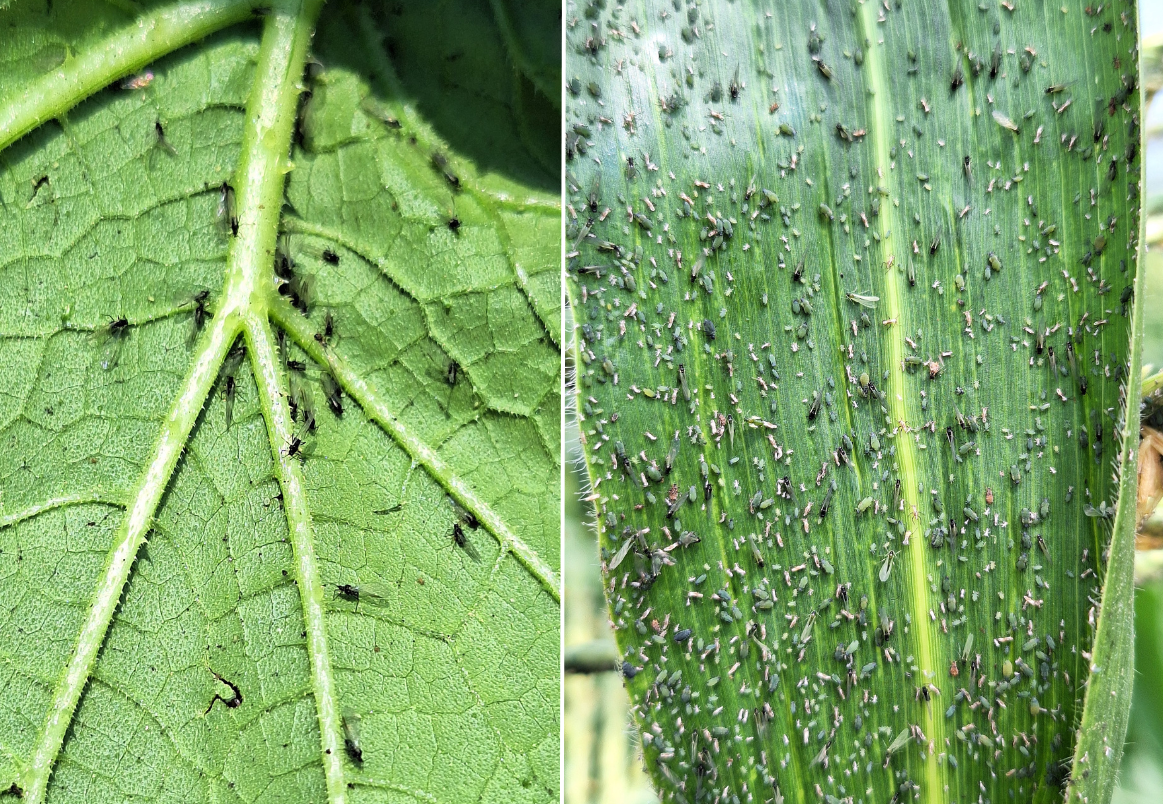
Hail damage
Hail damage was reported in Sanilac County the week of July 14. The damage from hail was observed in various vegetable crops and it varied depending on the crop, stage of growth and amount of injury. Disease control is important after hail damage as it can create openings for pathogens. Defoliation is one of the negative impacts on melons and other vine crops, as it will expose fruits to the sun. Direct damage to the fruit can make fruit unmarketable or of lower quality.
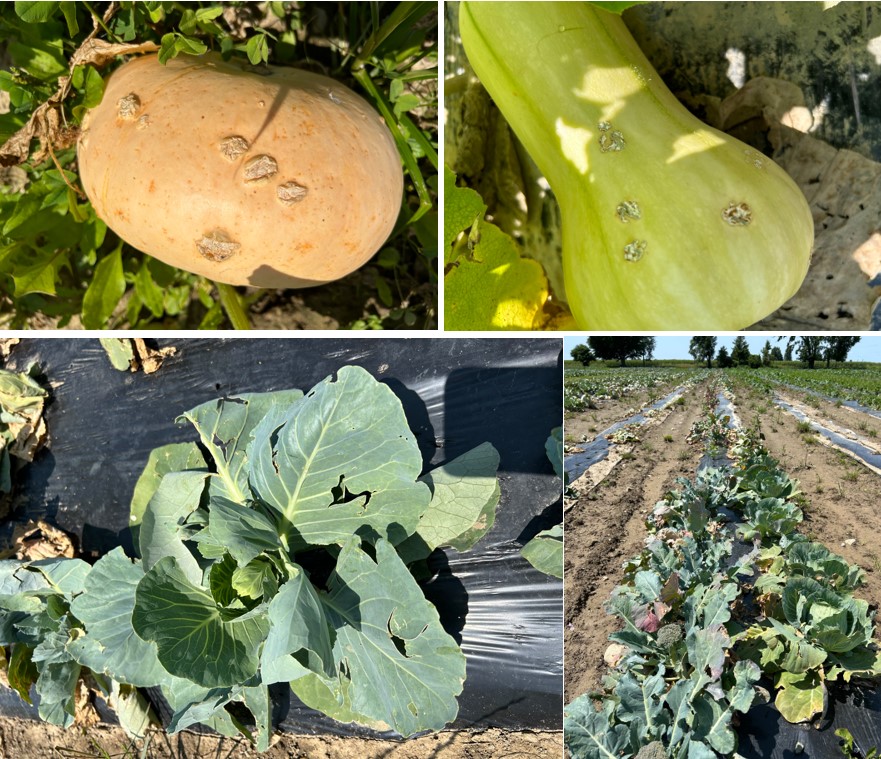
Crop updates
Asparagus
Growers are focusing on protecting asparagus fern from purple spot. The past few days were likely favorable given the muggy weather, and disease may advance even if fern currently appears relatively symptom free. Read more in the asparagus section of the July 17 report.
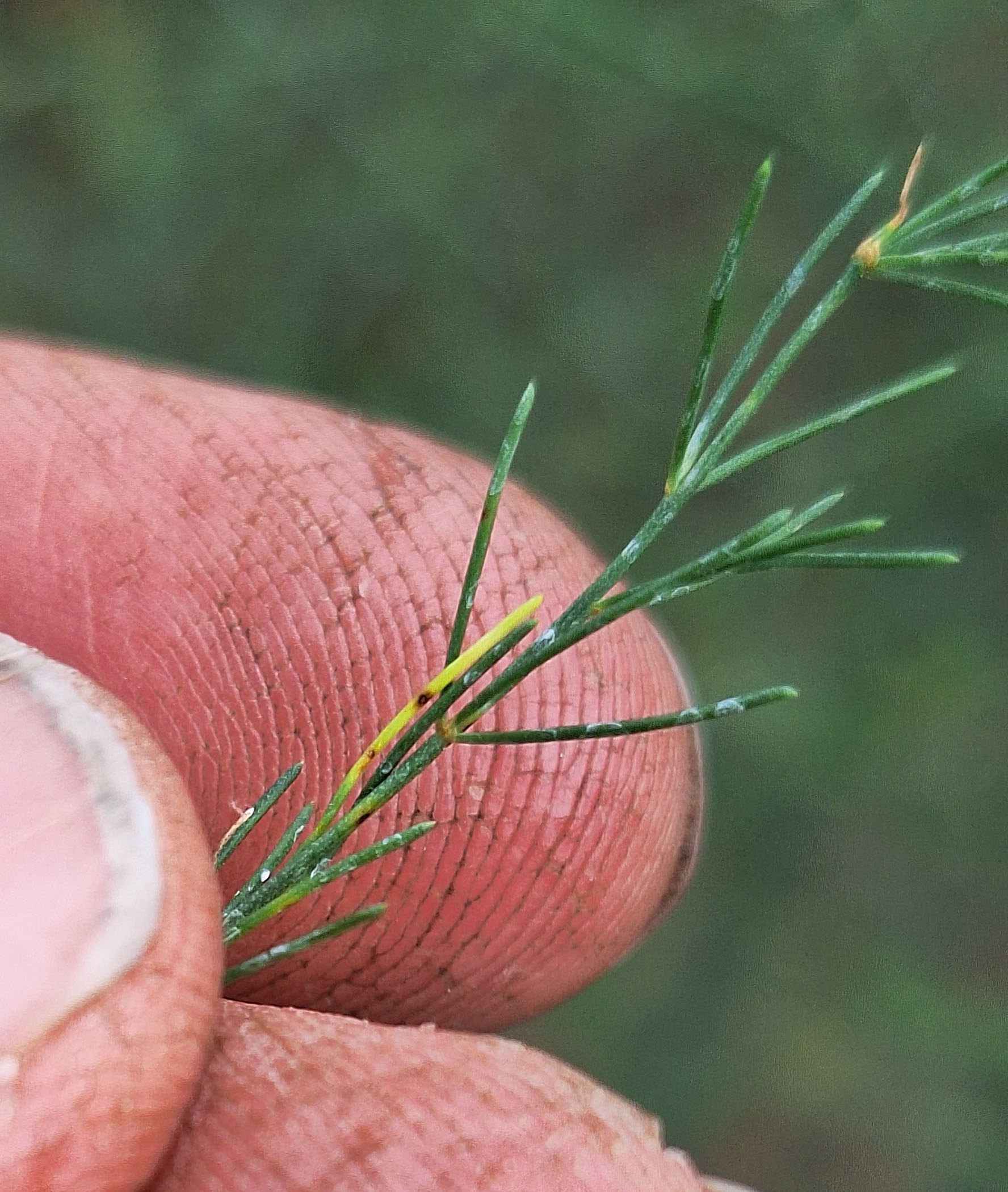
Brassicas and greens
Broccoli, kohlrabi, some cabbage, kale and salad mixes of all types are flowing into markets with new plantings being established. All caterpillars and beetles can be found, with thrips as well in some situations.
Tip burn in lettuce and brassicas can indicate a soil moisture-mediated calcium issue, similar to blossom end rot in tomatoes or peppers. This tends to occur on the young leaves, and so it can be especially troublesome in lettuce, cabbage and cauliflower, where the innermost leaves are either hidden inside the head or covered up when tied. These tissues initiate rots inside the lettuce or cabbage head and break down into unpleasant goo on cauliflower heads that have been tied. These tip-burned leaves can remain on broccoli and colored varieties of cauliflower and trimmed off at harvest. For multi-pick brassica greens, like collards or kale, tip burn tends not to be so severe, with some leaf edge curling but as not much necrosis. They can be marketable.
Carrots and celery
Scouts report that aphids have been present on the edges of some celery fields; growers have been successfully managing these to date.
Evidence of foliar disease was present in parts of at least some carrot fields earlier this week. Alternaria dauci infection can result in death of older leaves; necrosis tends to follow the leaf edge. Cercospora carotae may create more rounded lesions that can occur on old or new foliage and in leaf centers. Both can create petiole lesions and can be managed with a TOMCAST guided fungicide program. Bacterial diseases are managed differently and copper applications are necessary.
It is important to know which pathogen is responsible for the leaf blighting as the control strategies are different. Also, recent MSU vegetable research is finding that one of the root rots (Alternaria radicina) causes lesions on the foliage that are similar to that caused by Alternaria dauci. Alternaria radicina is much more destructive than Alternaria dauci due to its ability to cause root rot. Bacterial disease cannot be controlled using TOMCAST or those fungicides registered to manage Alternaria or Cercospora blight. It’s important to retain healthy tops for carrots to ensure maximum yield and quality and to ensure that the roots can be mechanically harvested.
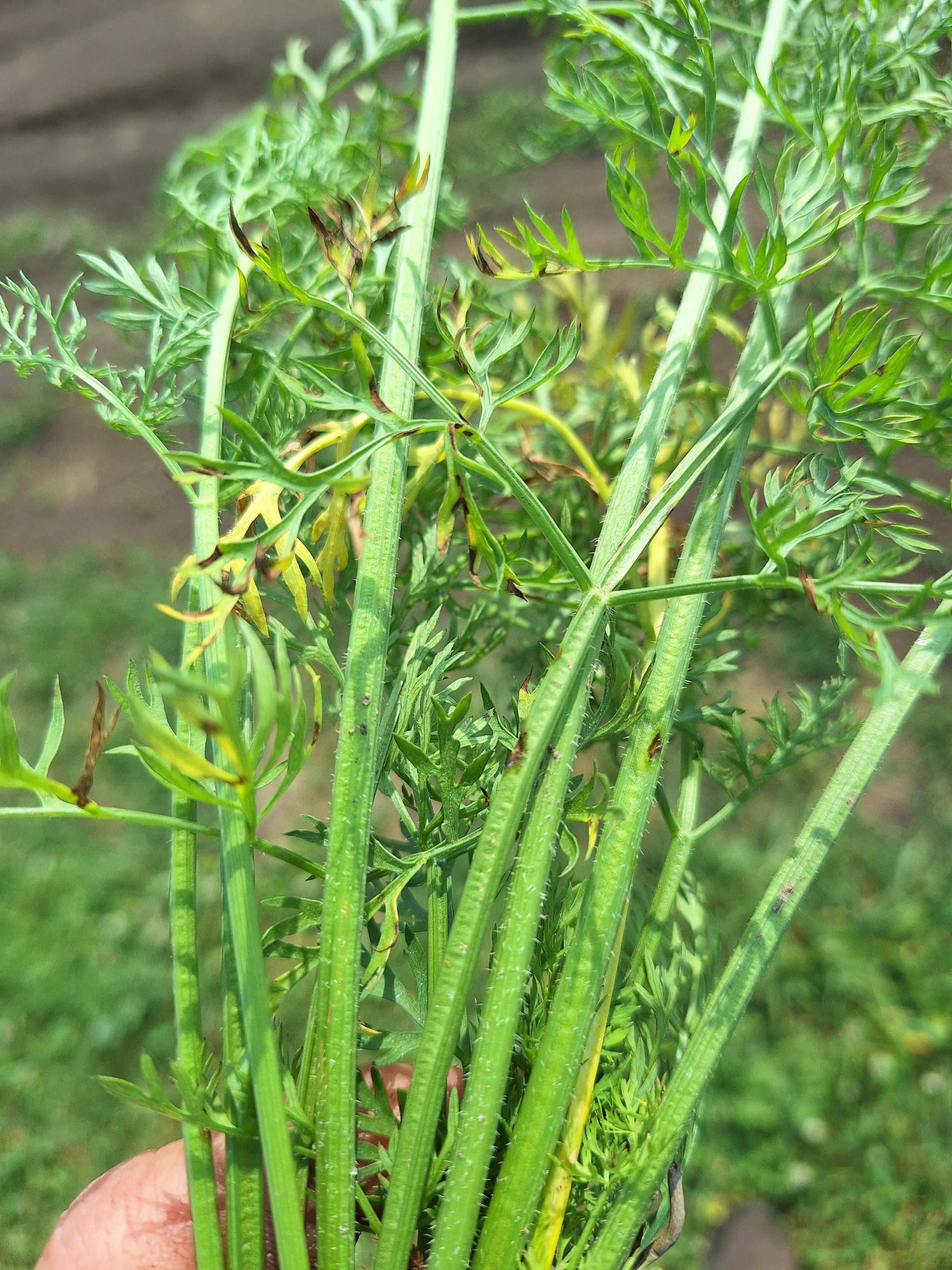
Cucurbits
All crops are being harvested, except pumpkins. Watermelons are still building in volume. Mechanical pickle harvests are stacking up.
Stay vigilant against downy mildew and Phytophthora pathogens. Downy mildew on cucumber has been confirmed in 13 Michigan counties across the major production regions. With several weeks of the growing season remaining, it is likely that this disease will become difficult to manage. In one commercial pickling cucumber field with a young planting, the cotyledons were heavily infected. Downy mildew is likely throughout the state on cucumber plantings even in those counties where we have not yet received confirmation of field symptoms. Michigan State University’s (MSU) spore trapping project continues to confirm the presence of clade 2 of the downy mildew pathogen, indicating cucumbers and melons are likely to become significantly diseased during this year’s outbreak. Mary Hausbeck’s MSU vegetable pathology program has developed short fact sheets that are regularly updated to include the most effective and recommended fungicides that have been shown in years of field trials to be effective against these destructive pathogens.
Phytophthora crown and fruit rot symptoms are likely to increase following some of the recent rains that many areas of the state have experienced. The symptoms can include blighting of the plant’s petioles and crown that lead to wilting. Fruit should not be harvested from regions of the field that are showing Phytophthora symptoms as the fruit may be infected but not develop rot symptoms until days later when the fruit are in transit or on grocery' shelves.
Eating melons brings joy. Selecting ripe melons from the field can generate the opposite feeling. One must be willing to allow the plant to train them, and to consult their seed reps. Trialing lots of new varieties can be overwhelming for timing harvests. The ultimate test of ripeness is to cut and taste a few sacrificial fruit every few days as you get close to the fruit size or color you are expecting. Another good but demoralizing sign is crow or racoon damage and lots of fruit flies.
Netted-skin cantaloupes, muskmelons and ananas are the easiest to determine ripeness. They have a powerfully sweet musky aroma, usually a light pink or yellow background color and the stem breaks free of the fruit with ease. Fruits that release themselves are too ripe.
Smooth-skinned honeydew types, canary’s, “toad skins” and oriental melons will not usually slip from the vine with a gentle tug, and they also do not emit a strong aroma. Some change color from green to yellow or orange or red as a reliable indicator of ripeness, but others do not. Flavor can sometimes improve with yellow fruit if left on the vine a little longer, which seems to be the case with oriental melons. If you pick any of these melons before they are ripe, the penalty is not severe. As close cousins to cucumbers — both are in the Cucumis genus — unripe melons taste just like cucumbers, while the sugar content turns up like a volume knob as they ripen. They also continue to ripen after picking, like tomatoes.
Watermelons are a different story. Unripe watermelons are rich in tannins that give the flesh an astringent and bitter taste, and they will not continue to ripen off the vine. There are many legends about picking a ripe watermelon, and almost all methods are subjective to your own senses, but four main signs are most reliable: 1) A bright, creamy yellow ground spot on the watermelon’s belly, 2) the pig-tail shaped tendrils that curl out of the leaf nodes should be brown and crispy where the fruit stem meets the vine and at the leaf nodes on either side of that point, 3) the blossom end should have some slight give to it, not solid and not mushy, and 4) thumping the watermelon with a knuckle should produce a hollow ring. We find this last method the most subjective, prone to misinterpretation, and least reliable. But it is the catchiest method shared because who can resist giving sturdy bruise-resistant fruit a good thwack?
Fruiting vegetables
Eggplants are going to market now, as well as peppers, tomatoes and okra.
Onions
Preparing for harvest of early, pungent yellow onions has started in west central Michigan.
Potatoes
Late blight has been detected in St. Joseph County, Michigan.
Sweet corn
Corn leaf aphid has arrived relatively early in larger numbers, colonizing some sweet corn plantings (see the section “Corn-belt aphids head up to Michigan” above for more information on their source). Aphids are easy to see on tassels. If you see aphids, check corn silks and ears where aphids can cause cosmetic issues. Pyrethroids like Brigade, Baythroid and Warrior (and generics) may be used to provide some aphid and earworm control (some of these are also in premixes with diamides). Good coverage is key. Pyrethroids will also kill aphid-eating beneficials. If a non-pyrethroid is desired, a neonicotinoid like acetamiprid (e.g., Assail) could be used; it will not help with earworm but will target aphids.
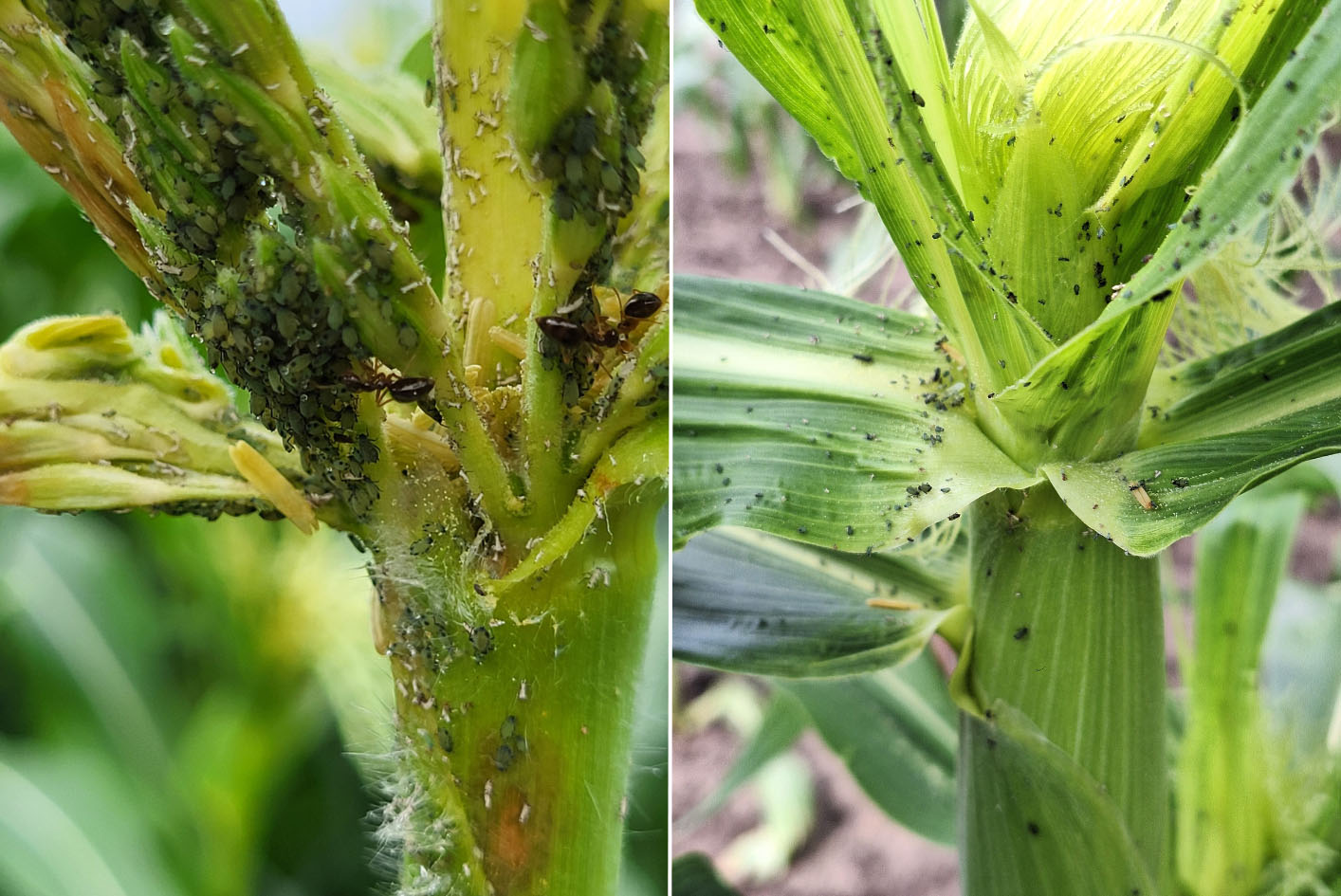
Corn earworm is present in numbers warranting management, but as of Monday, July 29, there was no evidence of the large flights more typical of August/September. Nightly earworm captures were mostly in the single digits at sites MSU Extension (see table below), Purdue University and Ohio State University are monitoring. The insect Forecast website suggests there could be a low risk of a flight overnight from July 31 – Aug. 1, so it could be good to check traps later this week.
|
Corn earworm captures. Total in trap for week1 (avg # per night2). |
||||||||
|---|---|---|---|---|---|---|---|---|
|
Week |
Monroe County |
Washtenaw County |
Oceana County |
Ottawa County |
Lapeer County |
Bay County |
Saginaw County |
Berrien County |
|
7/29 |
4 (0.5) |
0 (0.0) |
4 (0.7) |
13 (1.6) |
0 (0.0) |
0 (0.0) |
0 (0.0) |
3 (0.4) |
|
7/22 |
2 (0.4) |
0 (0.0) |
1 (0.1) |
0 (0.0) |
Not available |
1 (0.1) |
0 (0.0) |
4 (0.5) |
|
7/15 |
0 (0.0) |
1 (0.1) |
8 (1.1) |
15 (1.7) |
2 (0.3) |
0 (0.0) |
Not available |
Not available |
|
7/8 |
0 (0.0) |
2 (0.2) |
8 (1.1) |
14 (2.0) |
Not available |
Not available |
Not available |
Not available |
|
6/30 |
Not available |
Not available |
5 (1.0) |
30 (6.0) |
Not available |
Not available |
Not available |
Not available |
|
6/23 |
Not available |
Not available |
2 (1.0) |
Not available |
Not available |
Not available |
Not available |
Not available |
|
1Total number collected since last trap check; 2The total number divided by the number of nights since the last trap check. |
||||||||
Western bean cutworm captures declined at most locations MSU Extension is monitoring. Ohio State reported the peak is likely passing to our south.
|
Western bean cutworm captures. Total in trap for week1 (avg # per night2). |
|||||||
|---|---|---|---|---|---|---|---|
|
Week |
Monroe County |
Washtenaw County |
Oceana County |
Ottawa County |
Saginaw County |
Bay County |
Berrien County |
|
7/29 |
0 (0.0) |
1 (0.1) |
5 (0.8) |
40 (5.0) |
19 (2.7) |
6 (0.85) |
5 (0.7) |
|
7/22 |
2 (0.4) |
2 (0.3) |
17 (2.1) |
65 (16.2) |
352 (50.2) |
3 (0.4) |
1 (0.1) |
|
7/15 |
6 (0.7) |
26 (3.7) |
12 (1.7) |
190 (21.1) |
133 (19) |
Not available |
Not available |
|
7/8 |
5 (0.7) |
29 (3.6) |
3 (0.4) |
127 (18.1) |
26 (3.7) |
Not available |
Not available |
|
6/30 |
Not available |
Not available |
0 (0.0) |
11 ( 2.2) |
5 (0.7) |
Not available |
Not available |
|
6/23 |
Not available |
Not available |
0 (0.0) |
Not available |
5 (0.7) |
Not available |
Not available |
|
1Total number collected since last trap check; 2The total number divided by the number of nights since the last trap check |
|||||||
Earworm can be managed with pyrethroid, diamide and spinosyn insecticides. Pyrethroids are effective when moth pressure is not high, and include Hero, Ambush/Pounce, Asana, Baythroid, Brigade, Mustang Maxx and Warrior. Products with the diamide chlorantraniliprole (Besiege, Vantacor, Coragen) or the spinosyn spinetoram (Radiant, Intrepid Edge) are effective options for periods with high pressure. Spraying can be discontinued once corn has 90% brown silks, as it’s the green silks that attract egg laying females.
Events
- Aug. 1, 7-8 a.m., Field Crops Virtual Breakfast Series: Cover Crops After Wheat
- Aug. 2, 10 a.m.-2 p.m., Organic Inspection Field Day at The North Farm
- Aug. 8, 7-8 a.m., Field Crops Virtual Breakfast Series: MSU Diagnostic Lab Topics
- Aug. 8, Potato Field Day at the Montcalm Research Center, Lakeview, MI
- Aug. 12, Small Farms Conference, Benzonia, MI
- Aug. 13, Farming for the Future Field Day at the West Central Michigan Research and Extension Center, Hart, MI.
- Aug. 15, 7-8 a.m., Field Crops Virtual Breakfast Series: Field Crops Nematode Update
- Aug. 20, 6-8 p.m., Veggie Vibes at SWMREC
- Aug. 20, Bean and Beet Day at the Saginaw Valley Research and Extension Center, Frankenmuth, MI
- Aug. 22, 7-8 a.m., Field Crops Virtual Breakfast Series: Lime Recommendations for Field Crops
- Aug. 22, Summer Bus Tour and Annual Field Day at the Northwest Michigan Horticulture Research Center, Traverse City, MI
- Aug. 27, Drone Demonstration for Pest Management Meeting at the Northern Farm Market, Bruce Twp, MI
- Aug. 29, 7-8 a.m., Field Crops Virtual Breakfast Series: Maximizing Wheat Yield Potential
- Sept. 5, 7-8 a.m., Field Crops Virtual Breakfast Series: Drought-Proofing Agriculture with Drainage Water Recycling
- Sept. 5, 3-7 p.m., Organic Vegetable Production Workshop & Crop Walk, MSU Tollgate Center, Novi, MI
- Sept. 5, Long-Term Agroecosystems Research Field Day at the W. K. Kellogg Biological Station.
- Sept. 12, 7-8 a.m., Field Crops Virtual Breakfast Series: Grain Marketing
- Sept. 17, 6-8 p.m., Veggie Vibes at SWMREC
- Sept. 19, 7-8 a.m., Field Crops Virtual Breakfast Series: Late Season Weed Control
- Sept. 23, Field Day at the Trevor Nichols Research Center, Fennville, MI
This work is supported by the Crop Protection and Pest Management Program [grant no. 2021-70006-35450] from the USDA National Institute of Food and Agriculture. Any opinions, findings, conclusions, or recommendations expressed in this publication are those of the author(s) and do not necessarily reflect the view of the U.S. Department of Agriculture.



 Print
Print Email
Email




